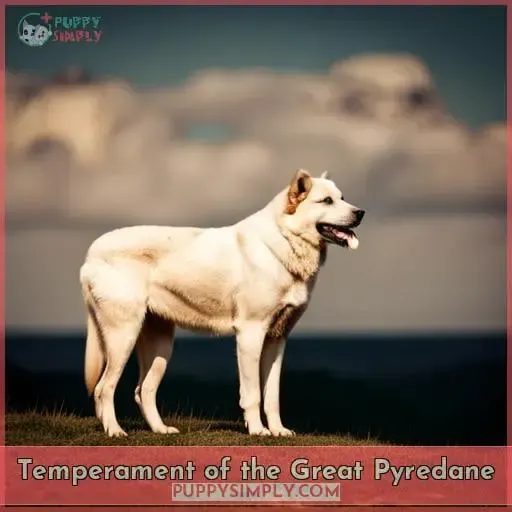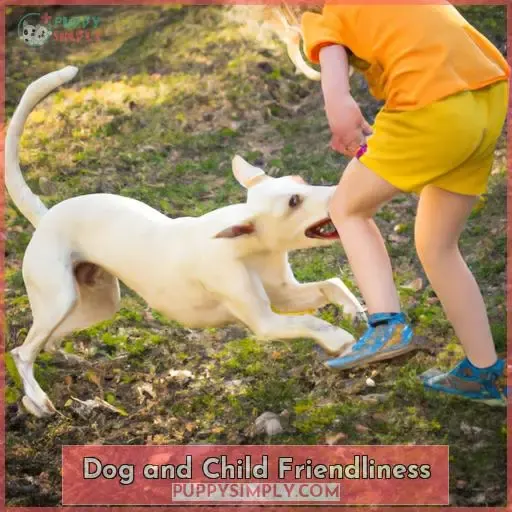This site is supported by our readers. We may earn a commission, at no cost to you, if you purchase through links.
 Embarking on the journey to learn more about the loyal and protective Great Pyredane is like stepping into a world of wonder. The majestic combination of two giants, that are both gentle and affectionate, creates an interesting dog with unique characteristics.
Embarking on the journey to learn more about the loyal and protective Great Pyredane is like stepping into a world of wonder. The majestic combination of two giants, that are both gentle and affectionate, creates an interesting dog with unique characteristics.
This article will provide all you need to know about this amazing mix between a Great Dane and a Great Pyrenees: from their size and appearance to their temperament, training needs, dietary requirements – even down to common health conditions they may face! Keep reading for an in-depth look at everything related to these wonderful dogs.
Table Of Contents
- Key Takeaways
- Great Pyredane Puppies
- Little-Known Facts
- Owning a Great Pyredane
- Benefits of Mixing the Breeds
- Size and Appearance
- Temperament of the Great Pyredane
- Protective Nature of the Great Dane Great Pyrenees Mix
- Aggression of the Great Pyredane
- Training Needs
- Exercise Needs
- Mental Stimulation
- Dog and Child Friendliness
- Intelligence of the Great Pyredane
- Nutrition
- Grooming Requirements
- Drooling Levels
- Barking Levels
- Common Health Conditions
- Cold Weather Tolerance
- Life Expectancy
- Puppy Prices
- Frequently Asked Questions (FAQs)
- Conclusion
Key Takeaways
- Appearance changes as they mature.
- Suitable for families with children and other pets.
- Intelligent and require mental stimulation.
- Socialization from an early age is important.
Great Pyredane Puppies
You’ll love cuddling with these adorable Great Pyredane puppies, whose soft fur and even-tempered personalities make them a perfect fit for your family. With their large size, they’re great protectors of home and family without being overly aggressive.
They have low exercise requirements but do need regular mental stimulation to stay satisfied—try playing games or teaching them new tricks! Socialization from an early age is important too, so that they know how to interact with small children or other animals in the household.
From a nutrition standpoint, portion control is key as this breed can easily overeat; limit treats and table scraps while making sure high-quality food designed for large dogs makes up most of their diet.
The Great Dane side brings loyalty and intelligence combined with the protective nature inherited from the Great Pyrenees means you’ve got yourself one fantastic pup who loves nothing more than spending time by your side – what could be better?
Little-Known Facts
You’ve chosen the perfect pet in the Great Dane Great Pyrenees Mix! This loyal and intelligent pup is protective of their home, with a Great Dane side that’s up to 3000 years old and a Great Pyrenees side that can be traced back 10,000 years.
As they age from puppyhood to adulthood, you’ll notice changes in their appearance, such as shorter fur. The mix is suitable for families with small children or other pets due to its even-tempered nature – it gets along well with both without excessive barking or chasing behavior.
Great Dane Side
You’ll love the loyalty and intelligence of your Great Pyredane’s Great Dane side. Fido is an obedient pup who loves to please his owners! Both breeds have a gentle giant nature that makes them perfect family pets, but the better-known breeders should be chosen for superior care.
With its long history, this large breed of dog needs exercise and regular grooming to stay healthy – plus, watch out for common diseases like Wobbler’s Syndrome or Osteosarcoma in later life.
Great Pyrenees Side
Fido’s Great Pyrenees side gives him a regal look and an ancient ancestry – this breed is believed to be over 10,000 years old! His friendly disposition makes it easy for him to get along with other pets and children.
Regular fur brushing, coat care, and playtime habits are necessary for his long life expectancy; health risks such as hip dysplasia should also be watched in older age. The Great Pyredane breed is known for its intelligence, loyalty, and protective nature, making them wonderful companions that will remain by your side throughout their long lives.
Appearance Changes
As he matures, you’ll notice his coat getting shorter and developing distinct patterns. His fur will change texture, and colors may vary from shades of gray to white with some black markings. His large rectangular head remains true to the Great Dane side, while his ears take on more of a shape similar to that of the Great Pyrenees side.
He is well-suited for cold climates due to the combination of both breeds’ coats, making him an ideal companion for those living in cooler regions.
Suitability for Families
With his even-tempered and mild-mannered personality, your Great Pyredane will be an affectionate addition to any family. Socializing him early is key, as well as daily walks and plenty of playtime activities.
Portion control should be monitored for this great companion, and reward-based training should start from day one! They are gentle giants that make great family pets when their good behavior is consistently reinforced.
Compatibility With Other Pets
You’ll find your Pyredane is friendly and sociable with other pets. Socializing him early on will help him get along well in the company of new people and other mixed-breed dogs. With a good reputation for getting along, he needs regular exercise, proper diet requirements to sustain his health, as well as good grooming habits.
Owning a Great Pyredane
As the proud owner of a Great Pyredane, you have found yourself with an intelligent and loyal protector. This breed’s diet should include high-quality food tailored to their size, supplemented with occasional treats.
Exercise needs are moderate, but regular exercise is necessary for mental stimulation, and training can be challenging yet rewarding. Proper grooming techniques must also be employed to maintain optimal health and reduce risks associated with certain conditions.
Food and Diet
You need to provide your Great Pyredane with high-quality food for their large size, feeding them 4-6 cups per day. Look for a grain-free brand and specialty foods that can meet their nutritional needs.
Exercise is also important; short bursts of activity are best complemented by mental stimulation like walks, games, and tricks.
Exercise
Exercise is essential for your Great Pyredane. Short bursts of activity, walks, games, and tricks provide mental stimulation. Dog-friendliness and child-friendliness require proper nutrition needs (4 to 6 cups per day).
Training
Training your Great Pyredane should start early with positive reinforcement, socialization strategies, and a variety of exercises. Portion control is key for this large breed; mental stimulation provides the brain exercise requirements.
Regular brushing helps prevent hip dysplasia, while proper training ensures a loyal companion with positive reinforcement.
Grooming
Regular grooming is necessary to keep your pup’s fur soft and shiny, prevent matting and ear infections, and maintain their regal appearance. Brushing techniques such as coat care and dental hygiene help reduce shedding. Ear cleaning should be part of the routine too! Regular brushing with good care, plus extra supplements like fatty acids, can lead to a healthier life for your Great Pyredane.
Health and Conditions
It is important to be aware of potential health issues when owning a Great Pyredane, such as hip dysplasia and bloat. The mix can also be prone to Wobbler’s Syndrome, Osteosarcoma, and cancer risk due to their Great Dane/Great Pyrenees heritage.
To ensure the best immune system for your pup, research reputable breeders who understand genetic diseases and provide proper care.
Benefits of Mixing the Breeds
By mixing the Great Dane and Great Pyrenees breeds together, you can get a loyal companion with an even-tempered personality who is great with families and other pets. The hybrid features of the crossbreed have numerous advantages, such as combining both breeds’ best qualities to create a strong and healthy dog.
They’re also more resistant to certain health conditions than purebred dogs due to their mixed genes.
This mix has an independent nature that makes them protective of home yet gentle enough for small children or seniors in need of companionship. The diet needed for these large dogs should include high-quality food tailored specifically for their size, accompanied by occasional treats.
This will help maintain good health throughout their lifetime while avoiding potential conditions like Wobblers Syndrome or Osteosarcoma, which may affect larger breeds from time to time.
Socialization should begin early on in life so they become confident around unfamiliar environments or people.
Long story short: if you’re looking for a loyal protector who loves being part of your family, then look no further than the amazing Great Pyredane!
Size and Appearance
You’ll be amazed by the size and regal appearance of the Great Pyredane. They stand tall at 27-30 inches with a large rectangular head. They come in shades of gray, white, and brown. Their fur is short but soft to touch.
This mix requires regular grooming due to its thick coat quality. Brushing twice weekly helps keep shedding levels low while also maintaining a healthy coat overall throughout its life cycle, which may reach up to 12 years in senior years.
It’s important for owners to provide high-quality food tailored specifically towards large breeds like this one – 4-6 cups per day should suffice! Mental stimulation is essential too, as these intelligent dogs love playing games or learning new tricks.
They also enjoy activities such as walking or swimming, which help them stay active during their lifetime.
Temperament of the Great Pyredane
The Great Pyredane is an even-tempered, gentle companion that makes a great addition to any family. Its thick fur coat has a soft texture and comes in shades of gray, white, and brown.
Though this mix may be prone to health concerns such as hip dysplasia or bloat later in life, daily exercise can help reduce the risks associated with these conditions.
Obedience training should start early for this intelligent breed; its independent nature requires consistency when teaching commands to ensure desired behaviors are achieved successfully over time.
The Great Pyredane’s loyal personality and protective instincts make it an excellent guard dog while still having the gentleness of the Great Pyrenees side shining through – making them perfect family pets!
They also get along well with other animals too, so if you have another pet at home already, they’ll fit right into your pack!
All in all, this Great Dane Weimaraner mix is sure to impress anyone who meets him!
Protective Nature of the Great Dane Great Pyrenees Mix
You’ll love the loyal, protective nature of your Great Pyredane! They are alert to strange activity and have watchful eyes, eager to please you. This mix is a perfect family pet. Their socialization benefits ensure that they get along well with other animals and children too.
Regular exercise should be included in their day-to-day routine to prevent health problems later in life. Consistent training also ensures that your pup will grow up into an obedient companion. Early training can help them learn commands more quickly and reduce any anxiety or fear caused by unfamiliar situations or noises.
Their protective instincts provide an extra layer of security for those living alone. However, it is important not to rely on this breed as its first line of defense against intruders due to its friendly disposition toward strangers when given proper socialization opportunities throughout its lifetime.
Aggression of the Great Pyredane
The Great Pyredane is a loyal, protective mix of the Great Dane and Great Pyrenees breeds. Although they can be quite gentle and easygoing, this breed needs proper socialization cues to help them learn how to behave around people and animals.
With their fearfulness toned down through early exposure to different situations from puppyhood onwards, your pup will have an easier time adjusting in any environment later on in life. The dominance hierarchy should also be addressed during training sessions for behavior modification purposes as well as for establishing breed standards that you wish your pup to follow at home or outside when going out with you or family members.
As both sides of the breed are livestock guard dogs by nature, it’s important that owners provide consistent care so that these traits don’t turn into aggression over time if not properly managed – something which can easily happen without proper guidance from day one! If given all the love they need coupled with the best traits of both parents (Great Dane & Pyrenees) plus regular exercise routines along with mental stimulation activities like playing games such as hide-and-seek every now and then – there’s no doubt about it: Your adorable yet strong companion will remain nothing but loyal until his last days.
Training Needs
The Great Dane Great Pyrenees Mix is a large, loyal, and protective canine companion. As such, it’s important that owners understand the training needs to ensure their pup grows up into an ideal pet.
Potty training should begin early and be consistent with positive reinforcement, while obedience classes can help teach them discipline in a controlled environment.
Potty Training
To potty train your Pyredane, you’ll need patience and consistency to ensure success. Develop a designated potty area outside for them to use with the help of warm water.
Incorporate bathroom habits into their daily routine by scheduling ten-minute sessions each day during high activity periods like after meals or playtime. Housebreaking tips, such as crate training and reward systems, can also be beneficial in teaching good behavior to both the Great Dane and Great Pyrenees sides of the mix.
Finally, provide plenty of positive reinforcement when they do something right. This will encourage more desirable behaviors while discouraging bad ones!
Obedience Training
Obedience training is essential for this intelligent breed, and with consistent positive reinforcement, your Pyredane can learn basic commands in a matter of weeks.
Welcoming puppies into your home is an exciting adventure but also requires patience and dedication. Positive reinforcement will help them develop their socialization skills while teaching them important commands like sit or stay that should be reinforced regularly.
Health prevention through regular vet visits and vaccinations are also key components when it comes to puppy development, as well as providing a good diet filled with quality ingredients tailored specifically for large breeds such as the Great Dane-Great Pyrenees mix.
Taking some extra time out of your day for physical exercise along with mental stimulation provides all-round benefits. Not only does it provide entertainment, but it also gives you both special moments together, making every outing enjoyable no matter how big or small.
The Great Dane-Great Pyrenees Mix is an amazing dog who makes a great addition to any family if provided plenty of love, attention, and guidance.
Exercise Needs
You’ll need to provide your pup with plenty of exercise, including walks, runs, swims, and agility training. The Great Dane Great Pyrenees Mix is a powerful dog breed that needs to be kept in check. As they are athletic by nature due to the Great Dane side of their heritage, it’s important you don’t let them get overweight or out of control when exercising, as this can increase their risk for health problems common in large-breed dogs, such as hip dysplasia and bloat.
Exercise sessions should be around 10 minutes for puppies under six months old and 20 minutes per day after that, but no more than an hour total. Any longer could lead to exhaustion, which isn’t good either! On top of providing physical activity, make sure you give your pup lots of mental stimulation too.
Play games with them or teach them new tricks; both will help keep their minds active while also strengthening the bond between pet parent and fur baby.
Additionally, always remember that weather protection is necessary. So, during hot days, shorten outdoor activities accordingly, while on cold days, take extra precautions like providing warm jackets if necessary (and advice from breeders caution).
Mental Stimulation
Provide your pup with plenty of mental stimulation – just like an apple a day keeps the doctor away! Including playing games and teaching them new tricks to keep their minds active. Socialization is key for this loyal, protective breed, so start early to ensure they are well-adjusted.
Positive reinforcement will go far in training your pup. Focus on agility and obedience exercises as these can help channel excess energy while providing valuable lessons in proper behavior. Vitamin C supplements can also benefit the Great Pyredane’s attention span when paired with portion control of high-quality brand dog food that meets their nutritional needs without overeating or obesity complications arising later on down the road.
Reserve table scraps or treats only for special occasions as they won’t get their teeth brushed every day, leading to potential ear infections if not careful! Lastly, choose a best guard dog that fits into any family dynamic but still gets enough exercise and love.
Dog and Child Friendliness
Your Great Pyredane is a fantastic addition to any home, and the bond between your pup and children can be especially strong.
In terms of socialization tips for your canine companion, it’s important to introduce them early on to other people or pets. Bonding activities like agility training or playing fetch are great ways for both child and pup alike to have fun together while building trust in one another.
When it comes down to nutrition, stick with high-quality dog food specifically formulated for large dogs such as yours – four cups per day should do the trick!
Your puppy’s safety also extends beyond food into more physical matters: keep joint pain at bay by avoiding long walks during cold weather conditions.
With proper care throughout its life expectancy of 8-12 years old, being one of the most popular dog breeds around today – you made an excellent choice in getting a Great Pyredane!
Intelligence of the Great Pyredane
The intelligent Great Pyredane is a wise choice for any family, combining the best attributes of both its parent breeds. This giant breed can excel in intelligence tests and loves mental stimulation, such as learning tricks or playing games.
Their cognitive abilities are on par with many other popular dog breeds, making them suitable for families that seek a loyal companion to join their ranks.
With proper care and exercise, they will live healthy lives filled with love and affection from their owners.
As this mix incorporates traits from two of the biggest dog breeds around today, it’s important to understand individual needs so that you know what kind of lifestyle your pup requires! Key reasons why these two have been mixed include increasing life expectancy while still deriving benefits like loyalty, protection, and companionship – all essential elements needed when bringing an animal into your home environment.
As this hybrid has grown more popular recently due to its gentle nature yet strong presence, make sure you provide plenty of opportunities for your pup’s physical activity along with activities meant specifically to stimulate his mind!
Nutrition
Greeting! Nutrition is an important part of keeping your Great Dane-Great Pyrenees Mix healthy. With the right balance of table scraps, dog treats, and supplements, you can ensure that they stay in good shape for many years to come.
Providing the best nutrition for these intelligent, loyal, and protective dogs will make them a wonderful addition to any home or family environment.
Table Scraps
You can treat your beloved Great Pyredane to the occasional table scrap, but remember to keep portions small due to their massive size. Positive reinforcement and supplement benefits are also recommended for this intelligent breed’s health.
With regular grooming and portion control, you can help prevent ear infections or other issues that may arise with a puppy from a mill.
Don’t forget though: these breeds have long lifespans, so make sure you provide enough exercise, including walks, runs, swimming sessions, and mental stimulation like learning new tricks, in order to ensure they remain healthy throughout their lives!
Dog Treats
Reward your Great Pyredane’s good behavior with natural, organic treats. Let them indulge in freeze-dried snacks that are packed with vitamin E for a healthy coat and tantalized taste buds. Homemade treats will give an extra special touch to their diet, while dental chews are perfect for keeping their teeth clean.
Supplements
Provide your pup with essential nutrients to stay healthy and active by adding supplements. The Great Dane side of the Great Pyredane is in need of mineral supplementation, joint support, digestive health, coat care, and muscle support.
Female Great Pyredanes require special attention as mountain dog mixes often benefit from citrus fruits in their diet.
Grooming Requirements
Grooming your Great Dane-Great Pyrenees Mix is an important step to keep them healthy and happy. Not only do they look better, but regular grooming also helps with their overall well-being.
This fluffy mountain dog requires some special care that may vary depending on where you live – it’s best to research the desired location before getting a mix breed from this region.
- Bathing Frequency – A once monthly bath is ideal, taking into account local climate conditions and the type of activities they participate in (e.
- Coat Care – Brushing several times per week will help reduce shedding and prevent matting of fur; use a brush specifically designed for double coats like this one!
- Ear Cleaning – Keeping ears clean can help reduce ear infections; check weekly or more frequently when swimming or after hikes in wet areas/seaside locations where sand can get stuck inside the ear canal!
- Dental Hygiene – Regular brushing & occasional dental chews are essential for proper oral hygiene & reducing plaque buildup which could lead to serious health issues down the road including heart problems due to bacteria entering through infected teeth into bloodstreams…so don’t forget about caring for those pearly whites!
- Feeding Habits – Give small amounts of bland food such as boiled chicken breast + rice every few hours throughout the day if possible instead of just 2 large meals so stomach acid levels stay balanced & puppy stays well-fed without overeating too much at once which leads to tummy troubles…yes, these great guard dogs eat lots but still need balance here too
Taking care of these five grooming requirements will ensure that you have a beautiful pup who won’t require trips back home often from being sickly due to improper upkeep by owners who forgot basics like the above-mentioned points.
Drooling Levels
Your furry friend may be the picture of regal beauty, but don’t let their gentle appearance fool you – they can drool like a fountain! Great Dane-Great Pyrenees Mix is no exception. Though genetics and facial anatomy play a role in how much slobber they produce, there are easy ways to control it.
Drooling Genetics
Breed Comparison
Saliva Quantity
Regulation: Genetic
Low
Control: Medium
Moderate
Prevention: High
High
Compared to other breeds, this new mix has lower saliva production due to its genetic makeup; however, male counterparts could have higher levels than females, so watch out for that! This breed loves swimming though, so if you’re not careful, it’s easy for them to become overly wet from all that drool – definitely use towels when playing with water outdoors or risk having one big mess on your hands afterwards
Despite these tendencies, there isn’t any real health concern associated with excessive salivating except maybe an increased risk of cancer down the road since bacteria tend to collect more easily inside moist environments.
Barking Levels
Though they’re not known to be excessive barkers, your Great Pyredane will alert you if something strange is afoot. Fortunately, these loyal and protective pups don’t take kindly to intruders, but their barking habits shouldn’t stop there! With the right dog training and plenty of exercise needs met, this breed can learn when it’s appropriate for them to vocalize.
Moreover, typical Great Dane characteristics make them particularly vocal breeds, so it’s important that owners give their pup enough time outside while being mindful not to over-exert larger breeds like this one.
When it comes down to nutrition guide and health conditions associated with loud barks such as hip dysplasia or bloat prevention, regular vet visits are essential in keeping an eye out on any potential issues before they arise.
All in all, though the Great Dane-Great Pyrenees mix may require more maintenance than some other dogs due to its size, with proper training techniques and patience from its owner, these furry friends have got what it takes for a long-term commitment!
Common Health Conditions
Regular vet visits are essential for keeping an eye out on common health conditions in your Great Pyredane, such as hip dysplasia and bloat. As an intelligent breed with a loyal and protective nature, it’s important to ensure they have the necessary vaccinations according to their age.
Genetic screening can also help identify any potential diseases or illnesses before they become severe.
A healthy diet should include lots of fresh food with high-quality proteins and carbohydrates, plus plenty of fiber every day.
Regular monitoring of specific health conditions will improve the quality of life for your beloved Great Dane Pyrenees mix while helping you stay informed about their needs along the way.
Cold Weather Tolerance
You’ll be glad to know that the Great Pyredane has a high tolerance for cold weather, so it can keep you company during those chilly winter nights! Thanks to its thick double coat, your pet will stay warm and comfortable outdoors.
To help protect them from the elements, ensure their fur is well-groomed and free of tangles or mats. Exercise needs should still be met even in colder conditions; take your pup on walks around different places or go running together for some great companionship.
They have relatively low nutrition requirements, but make sure not to overfeed as this could lead to health issues down the line.
With proper diet and exercise plus lots of love, your Great Pyredane will remain a nice pet throughout its entire life with you!
Life Expectancy
With proper care, your Pyredane can live for up to 10 years. To ensure they reach their full lifespan potential, there are several important factors to consider.
Genetics play a role; certain health problems may be linked to the breed and should be discussed with reputable breeders before purchasing a pup.
Feeding habits should also be monitored as portion control is key due to its large size; too much food could lead to obesity-related illnesses in later life.
Socialization needs must start from an early age and continue throughout adulthood as this helps them better adjust with other animals and people while reducing anxiety levels when around strangers or unfamiliar environments.
Exercise levels should meet daily requirements but not exceed them—too little activity can cause boredom which leads to destructive behaviors, while too much exercise increases the risk of injury if done incorrectly or over excessive periods of time at once!
Lastly, researching different breeder fees beforehand will help you find the best one that meets both your budget range and PuppyCare standards since inexperienced hobbyist breeders might charge lower prices yet use inferior parents, meaning more future medical bills down the line!
The Great Dane Great Pyrenees Mix makes fantastic family pets thanks to its gentle temperament, intelligence level, loyalty traits, and protective instincts.
Puppy Prices
The cost for a Great Pyredane puppy can vary widely, ranging from as little as $1,000 to over $3,000. This price range largely depends on the breeders used and their level of care given to the puppies.
For instance, higher-end breeders will charge more due to providing better quality parents and taking extra steps in health screening or even offering guarantees against certain conditions such as hip dysplasia or Wobblers Syndrome.
Price Range: $1K-$3K
Quality Care: High End Breeders
Guarantees Against Conditions: Yes
Lower fees: Inferior Parents & Health Screening
No
For those looking for a lower priced pup, it’s important to do your research beforehand since this may result in inferior pups with greater risks of developing serious health issues later down the line—even if they appear healthy now! Nutrition needs are also an important consideration; table scraps should be avoided while high-quality food is necessary, which may add additional costs depending on age/size requirements.
Additionally, the mix has low exercise needs but still requires regular short bursts of activity coupled with mental stimulation activities like agility training or learning new tricks reward them with treats! It’s essential that owners provide ample protection during cold weather plus consistent grooming sessions so matting is minimized along with any potential ear infections too!
The Great Pyredane makes an excellent companion when provided with all its necessities; loving, loyal, and intelligent, these dogs make fantastic family pets who will bring joy into any home provided proper care throughout its life expectancy up to 10 years old!
Frequently Asked Questions (FAQs)
Does the Great Pyredane require a lot of exercise?
The Great Pyredane requires exercise, but not as much as some other large breeds. You’ll need to provide it with short bursts of activity – walking, running, and playing games – to keep your pup happy and healthy.
Are Great Pyredane puppies easy to train?
Great Pyredane puppies are generally easy to train. With consistent positive reinforcement, they can learn tricks and obey commands quickly. They’re known for their intelligence and loyalty, making them protective of their family and home.
How much should a Great Pyredane be fed per day?
Feed your loyal, protective Great Pyredane four to six cups of high-quality food per day.
What types of health conditions is the Great Pyredane prone to?
The Great Pyredane is prone to minor conditions like Wobbler’s Syndrome and Osteosarcoma, as well as hip dysplasia and cancer in older age. Exercise, high-quality food, regular grooming, and socialization are essential for their health; take the necessary steps to ensure your pup’s longevity.
Does the Great Pyredane have a high tolerance for cold weather?
Yes, the Great Pyredane has a high tolerance for cold weather. Their thick coat and loyal nature make them well-suited to colder climates. They are intelligent enough to understand their limits in freezing temperatures and can be trusted outdoors when necessary.
Conclusion
As a loyal and protective pet, the Great Pyredane is a fantastic addition to any home. With its even-tempered nature, the Great Pyredane is sure to make a great companion and guard dog. With proper training and socialization, this mix can learn to be obedient and loving.
Their low exercise requirements and high mental stimulation needs make the Great Pyredane an ideal pet for busy or active individuals. With proper care, the Great Pyredane can live a long and healthy life. If you’re looking for a loyal and loving companion, the Great Pyredane is the perfect choice.



























